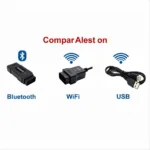OBD2 OBDII scanners are essential tools for car owners and mechanics alike, providing a window into the inner workings of a vehicle’s computer system. These devices allow you to read and understand diagnostic trouble codes (DTCs), monitor engine performance, and access a wealth of valuable data.
What is an OBD2 OBDII Scanner?
An OBD2 OBDII scanner, also known as a car diagnostic scanner, is an electronic device that connects to your car’s OBD2 port. This port, typically located under the dashboard on the driver’s side, allows access to the vehicle’s onboard diagnostic system.
Through this connection, the scanner can retrieve and display information about the engine, transmission, emissions system, and other critical components. This data can help you:
- Identify the root cause of warning lights on your dashboard.
- Monitor real-time engine parameters like speed, RPM, and temperature.
- Assess the health of your car’s emissions system.
- Detect potential problems before they become major repairs.
Types of OBD2 OBDII Scanners
There are various types of OBD2 OBDII scanners available, each catering to different needs and budgets. Some common types include:
1. Basic Code Readers
As the name suggests, these scanners are designed to read and clear basic diagnostic trouble codes. They are affordable and easy to use, making them ideal for car owners who want to get a general idea of why their check engine light is on.
2. Advanced Scan Tools
These scanners offer more features and functionality compared to basic code readers. They can provide live data streams, perform advanced diagnostics, and even program certain vehicle modules. Advanced scan tools are commonly used by professional mechanics and experienced DIY enthusiasts.
3. Bluetooth and WiFi Scanners
These scanners connect wirelessly to your smartphone or tablet, allowing you to access diagnostic information through dedicated apps. They offer a convenient and portable solution for car diagnostics.
How to Choose the Right OBD2 OBDII Scanner
With so many options available, choosing the right OBD2 OBDII scanner can seem daunting. Consider the following factors to make an informed decision:
- Your budget: Basic code readers are the most affordable, while advanced scan tools can be significantly more expensive.
- Your technical expertise: If you’re a beginner, a basic code reader or a user-friendly Bluetooth scanner might be sufficient. Experienced users might prefer the advanced features of a professional scan tool.
- Your vehicle’s make and model: Ensure the scanner you choose is compatible with your car.
- The features you need: Determine whether you need basic code reading capabilities or more advanced features like live data streaming and module programming.
Benefits of Using an OBD2 OBDII Scanner
Using an OBD2 OBDII scanner offers numerous benefits:
- Save money on repairs: By identifying problems early, you can avoid costly repairs down the line.
- Gain a better understanding of your car: OBD2 OBDII scanners provide valuable insights into your car’s health and performance.
- Increased peace of mind: Knowing that you can quickly diagnose and address car problems can give you greater peace of mind on the road.
- DIY diagnostics: OBD2 OBDII scanners empower car owners to perform their own basic diagnostics and maintenance.
Conclusion
An OBD2 OBDII scanner is an invaluable tool for any car owner or mechanic. Whether you’re looking to diagnose a check engine light, monitor engine performance, or simply gain a better understanding of your vehicle, an OBD2 OBDII scanner can provide the information you need. By choosing the right scanner for your needs and budget, you can unlock a wealth of information and potentially save yourself time and money on car repairs.
Frequently Asked Questions (FAQs)
1. What does OBD2 stand for?
OBD2 stands for On-Board Diagnostics, Second Generation. It’s a standardized system that allows external devices to access a vehicle’s diagnostic system.
2. Are all cars compatible with OBD2 OBDII scanners?
Most cars manufactured after 1996 in the United States and after 2001 in Europe are equipped with the OBD2 standard.
3. Can I use an OBD2 OBDII scanner on a diesel car?
Yes, many OBD2 OBDII scanners are compatible with both gasoline and diesel cars. However, it’s essential to check the scanner’s specifications to ensure compatibility.
4. Can I clear my check engine light with an OBD2 OBDII scanner?
Yes, most OBD2 OBDII scanners allow you to clear diagnostic trouble codes and turn off the check engine light. However, it’s crucial to address the underlying issue that triggered the light in the first place.
5. Do I need a professional mechanic to use an OBD2 OBDII scanner?
While basic code readers are user-friendly, more advanced scan tools might require some technical expertise. If you’re unsure, it’s always best to consult with a qualified mechanic.
For more information on specific OBD2 OBDII scanners, check out our reviews of the MaxiScan MS509 KW808 OBD2 OBDII EOBD, Panlong Bluetooth OBD2 OBDII Super Mini Auto Scanner, and ELM327 WiFi OBD2 OBDII Auto Diagnostic Scanner Tool Adapter. You can also find valuable resources and guides on KW808 EOBD OBD2 OBDII auto diagnostic scanner and the best free OBD2 PC software.
For personalized assistance, don’t hesitate to contact our 24/7 customer support via WhatsApp: +1(641)206-8880 or Email: [email protected].


